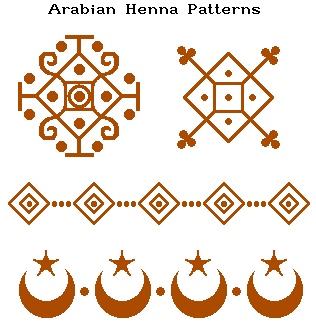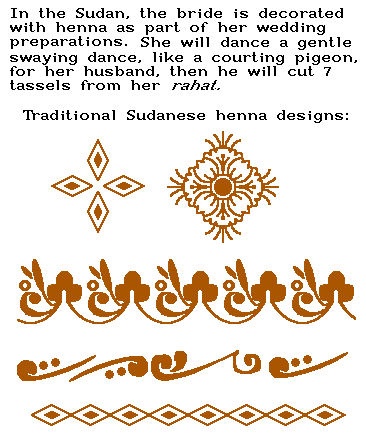
 K BILQIS
K BILQIS
 K BILQIS
K BILQISHOME
QUESTION
INDEX
INDEX
Monday, February 28, 2000
Note: The henna patterns on this page were created by Catherine Cartwright Jones. Ms. Jones is an expert on the history and traditions of henna back to 7000 BCE, and is working on "The Encyclopedia of Henna", a 900 page, 1000 illustration book on the subject. More of her work can be seen at http://www.mehandi.com/
|
QUESTION: Dear Bilqis, I'm wondering about a henna/mehindi party which is from the Pakistani tradition for my wedding. Does this have anything to do with Hindu customs? Is this bid'ah, innovation in religion? I'd like your opinion on this. -K |

|
BILQIS ANSWERS:
Dear K,
First, let us study the subject of bid'ah briefly. The following is an excerpt from the book, "Bidah, Innovation in Light of the Perfection of the Sharee'ah" by Shaik M. bin Saalih al-Uthaimeen:
Imaam Bukhaaree (may Allah have mercy on him) said:
"I met more than a thousand people of knowledge from the people of al-Hijaaz, al-Mecca, al-Madinah, al-Koofah, al-Basrah, Waasit, Baghdad, Shaam and Misr...and I never saw a single one of them differ with respect to the following matters...
...And they used to forbid and prevent (people) from innovations - those that the Messenger and his Companions were not upon, due to His (Allah's) saying:
'And hold fast, all of you together, to the Rope of Allah (i.e. this Qur'an), and be not divided among yourselves (3:103)'
and due to His saying:
'If you obey him (the Messenger), you shall be on the right guidance' (24:54)"
In these words of Imam Bukhaaree is a clear indication that Muslim unity is to be attained by removing the innovations - and that is the unanimous understanding of the greatest of scholars of the noble ayah in question. Since it is the newly-invented matters (in the issues of BELIEF, ACTION and METHODOLOGY) that have divided the hearts of the Muslims and set them against each other. Thus, in order for the hearts of the Muslims to unite and consequently, to be unified in their words and ranks, it is necessary for them to purify their beliefs, actions and methodologies from everything that was never taught by the Messenger and which was never acted upon by the Noble Companions...
Someone may say: "There are innovated things which the Muslims have accepted and have acted upon yet these things were not known during the time of the Messenger (peace be upon him) such as schools, composition of books and whatever resembles that. These are innovations which the Muslims have considered to be good, acted upon them and see them as being from the best of actions. How then can you reconcile between this which is almost unanimously agreed upon by the Muslims and between the speech of the leader of the Muslims, the Prophet of the Muslims and the Messenger of the Lord of all the worlds: "Every innovation is misguidance."
The answer: We say that this in reality is not an innovation. Rather it is a means to something which has been legislated in the Sharee'ah (Muslim Law). The means differ from place to place and time to time. It is from the established principles (in the Sharee'ah) that the means have rulings related to their intent or purpose. Therefore, ways and means for achieving something legislated are also legislated and permissible.
So, as you can see, Bidah is a very serious and well-defined matter within Sharee'ah. It has to do more specifically with issues of belief, actions of worship and Islamic methodology. Innovated things which fall outside the realm of worship therefore are not bid'ah. Henna parties, even though of a particular culture in origin do not tread on these issues of religion and are generally accepted as allowable.
However, if henna parties become so prevalent in a culture that one's wedding is considered incomplete without one, then it becomes bid'ah, because the requirements for marriage are a religious issue, and by making something mandatory which was not mandated by Allah or His Messenger (saws), people are encroaching upon Allah's rights and are innovating matters in the deen. Hopefully, you have a better understanding of what is "innovation".
| Lastly, the origin and use of henna are unclear. There is some historical evidence that mehndi (the application of henna to the body) as a ceremonial art form was originated in ancient India. But others believe the Moguls (the Muslims) introduced the use of henna to India in the 12th Century. It has been used for at least 5000 years as a cosmetic and for its supposed natural healing properties. There is documentation from archeologists that in ancient Egypt that henna was used to stain the fingers and toes of Pharaohs prior to mummification. It is still widely practiced in India, Pakistan, all the Arab world, and Africa. So it's an open issue, and we cannot conclude that it originated with the Hindus. |

|
Another issue to keep in mind, however, is the fact that a Muslim woman is not supposed to adorn herself in a manner to call attention to herself and show off her beauty.
The Qur'an says: "Say to the believing man that they should lower their gaze and guard their modesty; that will make for greater purity for them; and Allah is well acquainted with all that they do.
"And say to the believing women that they should lower their gaze and guard their modesty; and that they should not display their beauty and ornaments except what must ordinarily appear thereof; that they should draw their veils over their bosoms and not display their beauty except to their husbands..." (Qur'an 24:30-31)
Therefore, if the hennaed parts of the body are being displayed publicly in front of men, one could easily argue that this would be haram.
-Bilqis